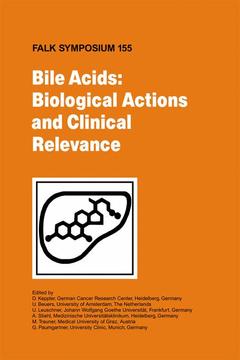Metabolism of bile acids.- Analysis of mice deficient in the bile acid biosynthetic enzyme 3?-hydroxy-?5-C27-steroid oxidoreductase (HSD3B7).- Role of oxysterols and cholestenoic acids in a crosstalk between the brain and the liver.- Activation of a G-protein coupled receptor by conjugated bile acids in primary hepatocytes and liver: effects on glucose metabolism.- Discovery of a novel oxysterol, 5-cholesten-3?, 25-diol 3-sulphate, in nuclei and mitochondria following over-expression of the gene encoding StarD1.- Hepatobiliary transport of bile acids.- Role of Ntcp phosphorylation in cAMP-mediated stimulation of hepatic bile acid uptake.- The concept of basolateral efflux pumps of the hepatocyte.- Insights into the regulation of expression of human OST?-OST?.- Regulation of hepatobiliary transport proteins in chronic cholestasis.- Assessment of inhibitory effect of many therapeutically important drugs on bile acid transport by NTCP, BSEP and other transporters.- Extrahepatocytic transport and actions of bile acids.- Extrahepatocytic transport of bile acids: the role of the cholangiocyte.- Molecular mechanisms of intestinal basolateral bile acid transport.- Regulation of intestinal bile acid transport in health and disease.- Evidence for a role of the FXR-driven intestinal regulatory factor FGF-19 upon cholestyramine and chenodeoxycholic acid treatment and during the diurnal regulation of bile acid synthesis in humans.- Nuclear receptor regulation.- Bile acid-like hormones function as ligands for the nematode orphan nuclear receptor DAF-12 and govern dauer formation, reproduction and lifespan.- Regulation of CYP7A1 by nuclear receptor signalling in human liver cells.- Regulation of hepatic and intestinal bile acid transport by FXR-controlled pathways.- Regulation ofbile acid homeostasis by the nuclear bile acid receptor FXR and fibroblast growth factor 15.- Bile salts activate endothelial no synthase in sinusoidal endothelial cells of the liver via the G-protein coupled receptor TGR5.- Bile acids, cellular injury, and disease mechanisms.- Bile salt-induced CD95 activation.- Role of Fas and caspase 8 in glycochenodeoxycholic acid-induced hepatocellular apoptosis in human liver cell lines.- Disulphated progesterone metabolites in urine relate to pruritus in intrahepatic cholestasis of pregnancy treated with ursodeoxycholic acid.- Adolf windaus prize lecture: primary biliary cirrhosis: from ursodeoxycholic acid towards targeting strategies for therapies.- Bile acids, cellular injury, and hepatic fibrosis.- Bile acids and liver fibrosis —Causative agent and therapeutic tool.- Mechanisms of bile acid-induced cell death in vivo and in vitro.- Bile acids enhance cellular motility of the hepatic myofibroblast-like cell through the regulation of p38/JNK signalling.- Bile acids as therapeutic agents: mechanisms and actions.- Side-chain-shortened bile acids for the treatment of cholestasis: lessons from nor-ursodeoxycholic acid.- Ursodeoxycholic acid-disulphate (SUDCA) — a potent chemopreventive agent against colon cancer.- Prevention of cholesterol gallstones by the potent cholesterol absorption inhibitor ezetimibe in gallstone-susceptible C57L/J mice.- Tauroursodeoxycholic acid antagonizes taurolithocholic acid-induced cholestasis via a cooperative protein kinase C-and protein kinase A-dependent signalling pathway in the perfused rat liver.- Bile acids in the treatment of cholestatic liver disease.- Ursodeoxycholic acid for the treatment of primary sclerosing cholangitis.- Role of polymorphisms in genes involved in bile aciddetoxification pathways in primary sclerosing cholangitis.- High-dose ursodeoxycholic acid in the treatment of primary sclerosing cholangitis.- Primary sclerosing cholangitis: bile duct and colonie carcinomas after long-term ursodeoxycholic acid.



